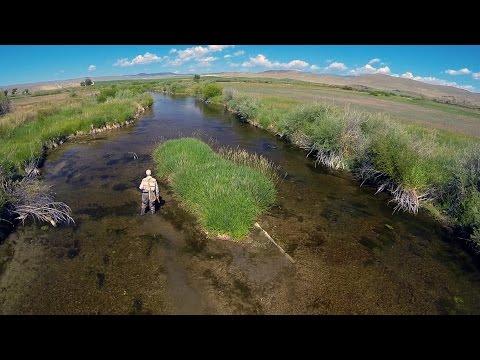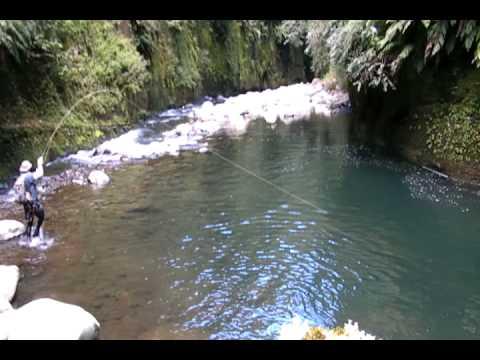The brown trout (salmo trutta) is a common and widely distributed member of the salmonidae family that gets its name from the yellow-orange-olive-brown sides, which are underneath dozens of black, brown, and red spots and iridescent cheeks. They are popular gamefish and can be found worldwide.
Brown Trout Size
Adult stream-dwelling (fluvial) brown trout usually grow to between 15 and 22 inches in length and between 1 and 5 pounds, depending on a variety of factors mostly related to habitat and genetics. Twenty-plus-inch brown trout are commonly considered a trophy catch for anglers. Adfluvial (lake-dwelling) adults can reach larger sizes on average due to the fact that they burn fewer calories fighting the current to find food – in rare instances reaching more than 20 pounds.
Brown Trout Native Range
Brown trout are native to most of Europe (including France, Germany, Greece, Iceland, Ireland, Norway, Russia, and Sweden), a small swath of northern Africa (including Tunisia, Algeria, and Morocco) and western Asia (including parts of Afghanistan, Armenia, Pakistan, and Turkey).
Brown Trout Habitat
Brown trout habitat includes cold freshwater streams, rivers, lakes, and ponds, and for sea-run brown trout, cold parts of the Atlantic Ocean where the average temperature stays below .
Brown trout are more predatory and piscivorous than many other species of trout, thus are more likely to eat baitfish flies (streamers) than other trout species. (Ross Purnell photo)
Brown Trout Life Cycle
Sexually mature brown trout typically spawn in fall. Browns will migrate upstream (usually) to their natal spawning grounds to lay and fertilize thousands of eggs per fish in spawning beds known as redds. In one to two months (depending on habitat), eggs hatch into what are called fry (baby fish), then fingerlings (juvenile fish), and they are considered adults by the end of their first to third years when they are capable of spawning their own eggs. They typically live four to six years, but can live to be older than 10 with the right circumstances.
Brown Trout Diet
Brown trout feed primarily on all stages of aquatic invertebrates like mayflies, caddisflies, stoneflies, midges, and crustaceans (scuds, sowbugs, and crayfish), and small baitfish including of their own species. They also eat fish eggs [J1] when present, worms (both aquatic and terrestrial annelids), zooplankton, and daphnia in stillwaters (lakes, reservoirs,
Strains of Brown Trout
There are different “strains” or subtypes of brown trout, which means they’re the same species so they can mate with other strains, but have slight genetic differences that affect when they spawn, how fast they grow, diet, and details in their appearance. They are often named after a native fishery or the hatchery where they’re bred. Some strains include: Seeforellen, Loch Leven, German, Wild Rose, Plymouth Rock, Gillaroo, and Sonaghen.
Brown trout are distributed worldwide, thanks largely to being stocked by humans because of their adaptable, hardy, and sporting nature. Brown trout are now found in every continent except the Arctic and Antarctica, 45 of the 50 U.S. states and many Canadian provinces.
As much as anglers and wildlife enthusiasts value brown trout, and as important as they are to their native ecosystems, their introductions to non-native waters worldwide have been detrimental to certain native fish populations. In the Rocky Mountains, for example, the introduction of non-native browns (and rainbows) have decimated native cutthroat trout and Arctic grayling populations due to out-competing them – brown trout (along with rainbow trout, in many locales) are more assertive and dominate prime feeding lies and spawning grounds compared to these native species. The same has happened to the Arctic grayling in the Lower 48. The effect is less pronounced in locations that did not have native trout populations (New Zealand and South America).
Native range (Europe, northern Africa, western Asia): Brown trout are native to portions of Europe, northwestern Africa, and western Asia.
In Europe their native range extends from Iceland and northern Norway south throughout the entirety of Europe.
This range also extends to the tributaries of the Aral Sea in parts of Afghanistan and Pakistan, in far western Asia
Fly Fishing for Brown Trout
Brown trout are one of the most popular fish to target with fly gear for many reasons, the biggest of which include that they willingly eat aquatic insects and can be challenging to fool.
Three- to 6-weight rods are the most effective for targeting brown trout, most often on floating fly lines that match the rod size. Fly selection will depend on the available bugs in a given fishery or region, and the season. But standard dry flies (Parachute Adams, Elk Hair Caddis, hoppers, etc.), nymphs (Prince Nymphs, Hare’s Ears, Pheasant Tails, Girdle Bugs, etc.), and streamers (Woolly Buggers, Muddler Minnows, sculpin patterns, etc.)
Brown Trout Size
Adult stream-dwelling (fluvial) brown trout usually grow to between 15 and 22 inches in length and between 1 and 5 pounds, depending on a variety of factors mostly related to habitat and genetics. Twenty-plus-inch brown trout are commonly considered a trophy catch for anglers. Adfluvial (lake-dwelling) adults can reach larger sizes on average due to the fact that they burn fewer calories fighting the current to find food – in rare instances reaching more than 20 pounds.
Brown Trout Native Range
Brown trout are native to most of Europe (including France, Germany, Greece, Iceland, Ireland, Norway, Russia, and Sweden), a small swath of northern Africa (including Tunisia, Algeria, and Morocco) and western Asia (including parts of Afghanistan, Armenia, Pakistan, and Turkey).
Brown Trout Habitat
Brown trout habitat includes cold freshwater streams, rivers, lakes, and ponds, and for sea-run brown trout, cold parts of the Atlantic Ocean where the average temperature stays below .
Brown trout are more predatory and piscivorous than many other species of trout, thus are more likely to eat baitfish flies (streamers) than other trout species. (Ross Purnell photo)
Brown Trout Life Cycle
Sexually mature brown trout typically spawn in fall. Browns will migrate upstream (usually) to their natal spawning grounds to lay and fertilize thousands of eggs per fish in spawning beds known as redds. In one to two months (depending on habitat), eggs hatch into what are called fry (baby fish), then fingerlings (juvenile fish), and they are considered adults by the end of their first to third years when they are capable of spawning their own eggs. They typically live four to six years, but can live to be older than 10 with the right circumstances.
Brown Trout Diet
Brown trout feed primarily on all stages of aquatic invertebrates like mayflies, caddisflies, stoneflies, midges, and crustaceans (scuds, sowbugs, and crayfish), and small baitfish including of their own species. They also eat fish eggs [J1] when present, worms (both aquatic and terrestrial annelids), zooplankton, and daphnia in stillwaters (lakes, reservoirs,
Strains of Brown Trout
There are different “strains” or subtypes of brown trout, which means they’re the same species so they can mate with other strains, but have slight genetic differences that affect when they spawn, how fast they grow, diet, and details in their appearance. They are often named after a native fishery or the hatchery where they’re bred. Some strains include: Seeforellen, Loch Leven, German, Wild Rose, Plymouth Rock, Gillaroo, and Sonaghen.
Brown trout are distributed worldwide, thanks largely to being stocked by humans because of their adaptable, hardy, and sporting nature. Brown trout are now found in every continent except the Arctic and Antarctica, 45 of the 50 U.S. states and many Canadian provinces.
As much as anglers and wildlife enthusiasts value brown trout, and as important as they are to their native ecosystems, their introductions to non-native waters worldwide have been detrimental to certain native fish populations. In the Rocky Mountains, for example, the introduction of non-native browns (and rainbows) have decimated native cutthroat trout and Arctic grayling populations due to out-competing them – brown trout (along with rainbow trout, in many locales) are more assertive and dominate prime feeding lies and spawning grounds compared to these native species. The same has happened to the Arctic grayling in the Lower 48. The effect is less pronounced in locations that did not have native trout populations (New Zealand and South America).
Native range (Europe, northern Africa, western Asia): Brown trout are native to portions of Europe, northwestern Africa, and western Asia.
In Europe their native range extends from Iceland and northern Norway south throughout the entirety of Europe.
This range also extends to the tributaries of the Aral Sea in parts of Afghanistan and Pakistan, in far western Asia
Fly Fishing for Brown Trout
Brown trout are one of the most popular fish to target with fly gear for many reasons, the biggest of which include that they willingly eat aquatic insects and can be challenging to fool.
Three- to 6-weight rods are the most effective for targeting brown trout, most often on floating fly lines that match the rod size. Fly selection will depend on the available bugs in a given fishery or region, and the season. But standard dry flies (Parachute Adams, Elk Hair Caddis, hoppers, etc.), nymphs (Prince Nymphs, Hare’s Ears, Pheasant Tails, Girdle Bugs, etc.), and streamers (Woolly Buggers, Muddler Minnows, sculpin patterns, etc.)
- Category
- Fly Fishing




